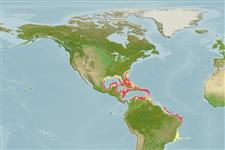Classification / Names
Nomi Comuni | Sinonimi | Catalog of Fishes(Genere, Specie) | ITIS | CoL | WoRMS | Cloffa
>
Ophidiiformes (Cusk eels) >
Ophidiidae (Cusk-eels) > Neobythitinae
Etymology: Neobythites: Greek, neos = new + Greek, bythitis, -idos = it is at the bottom, sunken (Ref. 45335); multiocellatus: The specific name refers to the high number of ocelli (>2) on the dorsal fin (Ref. 82372).
More on authors: Nielsen, Uiblein & Mincarone.
Environment: milieu / climate zone / depth range / distribution range
Ecologia
marino batidemersale; distribuzione batimetrica 102 - 770 m (Ref. 82371). Tropical
Distribuzione
Stati | Aree FAO | Ecosystems | Presenze | Point map | Introduzioni | Faunafri
Neobythites multiocellatus is recorded from most of the Caribbean Sea northwards to off the Atlantic coast of Florida (Ref. 82372).
Size / Peso / Age
Maturity: Lm ? range ? - ? cm
Max length : 14.3 cm SL maschio/sesso non determinato; (Ref. 82372)
Short description
Morfologia | Morfometria
Neobythites multiocellatus differs from the other eight West Atlantic Neobythites species by having 3 (rarely 4) ocelli on the dorsal fin, the anterior of which is placed somewhat behind a line through the origin of the anal fin, and by the following combination of characters: 0–1(weak) spine on hind margin of preopercle, total number of vertebrae 54–59, dorsal fin rays 94–101, anal fin rays 79–90 (Ref. 82372).
Life cycle and mating behavior
Maturità | Riproduzione | Deposizione | Uova | Fecundity | Larve
Nielsen, J.G., F. Uiblein and M.M. Mincarone, 2009. Ocellus-bearing Neobythites species (Teleostei: Ophidiidae) from the West Atlantic with description of a new species. Zootaxa 2228:57-68. (Ref. 82372)
IUCN Red List Status (Ref. 130435)
Threat to humans
Harmless
Human uses
Informazioni ulteriori
Nomi ComuniSinonimiMetabolismoPredatoriEcotossicologiaRiproduzioneMaturitàDeposizioneSpawning aggregationFecundityUovaEgg development
Age/SizeAccrescimentoLength-weightLength-lengthLength-frequenciesMorfometriaMorfologiaLarveDinamica popolazioni larvaliReclutamentoAbbondanzaBRUVS
BibliografiaAcquacolturaProfilo di acquacolturaVarietàGeneticaElectrophoresesEreditarietàMalattieElaborazioneNutrientsMass conversion
CollaboratoriImmaginiStamps, Coins Misc.SuoniCiguateraVelocitàModalità di nuotoArea branchialeOtolithsCervelliVista
Strumenti
Special reports
Download XML
Fonti Internet
Estimates based on models
Preferred temperature (Ref.
123201): 10.8 - 21, mean 15.4 °C (based on 90 cells).
Phylogenetic diversity index (Ref.
82804): PD
50 = 0.5000 [Uniqueness, from 0.5 = low to 2.0 = high].
Bayesian length-weight: a=0.00380 (0.00165 - 0.00876), b=3.14 (2.93 - 3.35), in cm total length, based on LWR estimates for this (Sub)family-body shape (Ref.
93245).
Trophic level (Ref.
69278): 3.5 ±0.5 se; based on size and trophs of closest relatives
Resilienza (Ref.
120179): Alto, tempo minimo di raddoppiamento della popolazione meno di 15 mesi (Preliminary K or Fecundity.).
Fishing Vulnerability (Ref.
59153): Low vulnerability (10 of 100).
